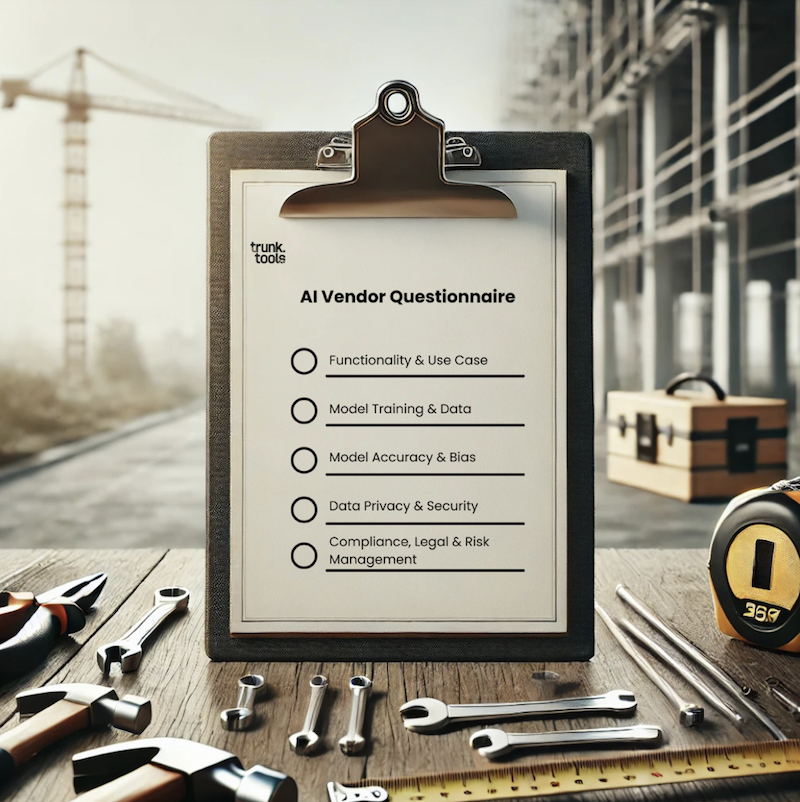
This article is the result of a shared commitment by BuiltWorlds and Trunk Tools to help construction professionals navigate the rapidly evolving AI landscape with confidence. By combining Trunk Tools’ deep expertise in AI development with BuiltWorlds’ independent industry perspective, we aim to provide practical guidance that empowers companies to ask the right questions, demand transparency, and make AI investments that truly deliver value.
The AI landscape is noisy. Every vendor claims to have groundbreaking technology, but few turn out to be anything more than flashy demos and exaggerated marketing. AI is poised to transform construction, yet many solutions fail to deliver measurable value in the field. The challenge isn’t just choosing the right AI vendor—it’s knowing what questions to ask.
Trunk Tools has spent years developing AI specifically for construction, refining its approach through hands-on experience. Alongside top AI legal experts and our customers, the team created an AI Vendor Questionnaire in hopes of setting a higher standard for evaluating AI solutions. Whether evaluating a new tool or scrutinizing a long-term investment, this framework is designed to favor real answers over buzzwords.
Effectively Evaluating AI for AEC
Not all AI is created equal. To make an informed decision, companies should assess vendors across five key dimensions:
- Functionality & Use Case – AI should solve a real, field-tested problem. “If an AI vendor can’t prove a measurable impact for the problem it is trying to solve, it’s not a viable solution,” says Hrishi Maha, director of AI/ML for DPR Construction. “We need AI that truly moves the needle on efficiency, cost savings, and project performance—not just promises on paper.”
- Model Training & Data – AI relies on strong data foundations. “Preparing your own internal data for success, understanding how vendors handle your data, how they enrich it with industry specific context, how they work with it and refine it, and how they safeguard your security is critical,” notes Jit Kee Chin, CTO for Suffolk Construction and co-founder of Suffolk Technology. “Construction data is complex and deeply contextual, and precision of responses is critical for usefulness. If an AI model isn’t trained on real-world, jobsite-specific data, it won’t deliver results—it’ll just add noise.”
- Model Accuracy & Bias – AI models must be reliable, consistent, and free from harmful bias. Understanding how a vendor tests and measures accuracy, mitigates bias, and ensures fair outcomes is essential for making informed decisions. If an AI’s outputs impact safety, budgets, or schedules, companies need confidence that those results are based on high-quality, representative data.
- Data Privacy & Security – AI introduces new security risks. From project drawings to worker safety data, ensuring compliance with industry regulations is non-negotiable. “We’re not just protecting files—we’re protecting people, projects, reputations, and above all, our clients” adds Robert Leon, CIO for STO Building Group. “If an AI vendor doesn’t take security and compliance as seriously as we do, then we can not work with them.”
- Compliance, Legal & Risk Management – Contractual clarity is essential. AI vendors should disclose how their models evolve, who owns derivative data, and what happens if the AI underperforms. Reviewing Master Service Agreements (MSAs) closely can reveal hidden risks. “AI contracts aren’t just another software agreement—the continuous evolution of AI models introduces unique risks around data ownership and liability that needs to be contemplated by the contract,” says Nate Budde, former CLO of Levelset, now GC at Trunk Tools. “Companies should carefully scrutinize MSAs to ensure they aren’t unknowingly giving up control over their data or assuming undue risk as AI continues to develop.”

Effectively Evaluating AI Solutions Providers
Beyond assessing an AI tool’s capabilities, it’s also important to evaluate the company and team behind it. A vendor’s technical expertise and financial stability can indicate whether their AI product is built for long-term success. Companies should look at the depth of AI/ML experience within the team—both among engineers and leadership—and whether development is done in-house or outsourced. The financial strength of the company also matters, as AI development is resource-intensive. Understanding a vendor’s total funding, strategic partnerships, and investment history can provide insight into their ability to sustain innovation and support customers over time.
While knowing what to look for in an AI vendor is critical, having a structured approach to evaluation makes all the difference. Buying AI requires more than a checklist—it demands a structured approach that asks the right questions:
- Does their AI product improve efficiency on-site—not just in theory?
- How does it handle data security & compliance?
- Can it actually integrate with existing workflows?
These aren’t abstract concerns; they determine whether an AI solution will work in the field or become shelfware.
Mitigating Risk in AI Contracts
Even after choosing the right vendor, customers should ensure their contracts protect them from unnecessary risk. AI contracts introduce unique challenges. Unlike traditional software agreements, AI models evolve over time, potentially shifting performance and compliance risks. Before signing any AI deal, here are key areas that require careful scrutiny:
- Data Ownership & Model Training – Who owns the data fed into the AI system, and does the vendor use it to improve their models? Many AI contracts grant vendors broad rights to process, analyze, and aggregate customer data. Others explicitly commit to not using customer data for training external AI models, a safeguard that should be standard practice.
- Liability & Performance Guarantees – What happens if the AI makes an incorrect decision that leads to costly mistakes? Many AI contracts limit vendor liability, capping damages and placing the burden of verifying AI-generated insights on the customer. Construction firms should negotiate for clear performance commitments and liability protections.
- Security & Compliance Risks – AI tools often integrate with other software, raising potential cybersecurity concerns. Contracts should explicitly define security measures, data protection protocols, and compliance with industry standards like SOC 2.
- Model Updates & Version Control – AI models change over time, and updates may alter performance. Some vendors reserve the right to modify models unilaterally, which can impact accuracy and usability. Contracts should specify how updates are handled and whether customers have a say in major changes.
- Service Levels & Downtime – AI tools need to be reliable. Many contracts include uptime guarantees but may exclude critical failures caused by third-party dependencies. Reviewing service-level agreements (SLAs) can prevent unpleasant surprises when AI downtime affects business operations.
- Exit Terms & Data Portability – If you stop using an AI tool, can you retrieve all your data? Some contracts allow vendors to retain customer data even after termination. Ensuring clear data deletion and portability provisions is essential to maintaining control over your own information.
A thorough review of the MSA is essential before signing any AI deal to ensure AI investments are both secure and sustainable.
AI has the potential to reshape industries, but the success of any AI investment hinges on rigorous vendor evaluation, thoughtful contract negotiations, and a deep understanding of how AI models function in real-world applications. Companies that blindly adopt AI based on marketing promises risk disappointment—or worse, unintended security, compliance, and liability issues. By focusing on functionality, transparency, security, and legal safeguards, businesses can ensure they’re adopting AI that not only works but delivers tangible value.
“AI adoption isn’t just about innovation—it’s about making real, sustainable change that benefits the entire industry,” says Dr. Sarah Buchner, CEO of Trunk Tools.


Discussion
Be the first to leave a comment.
You must be a member of the BuiltWorlds community to join the discussion.